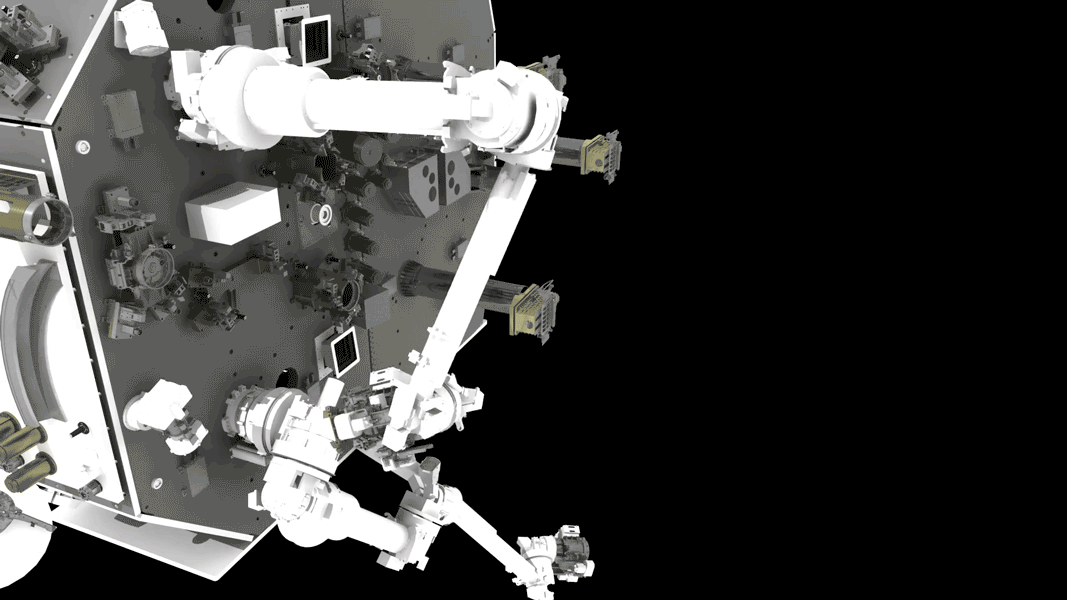NASA
Boeing Reveals New Space Suit Design for Starliner Missions
The snazzy outfit, unveiled at the Kennedy Space Center, is expected to be worn by astronauts starting in 2023
NASA’s New Solar Sail Could Soon Navigate in Space
Scientists say the flashy tech could help them study the sun’s polar regions
Dusty InSight Mars Lander Takes Its Final Selfie
The Red Planet probe will likely stop operating sometime later this year
NASA Snaps Photos of Underwater 'Sharkcano' Erupting
Kavachi, a submarine volcano in the southwest Pacific Ocean, is home to several species of sharks and fish that can withstand the extreme environment
Boeing's Starliner Reaches the International Space Station
After two and a half years of issues, the spacecraft's successful arrival is an important next step in NASA's commercial crew program
Why NASA Scientists Want to Send Nudes to Space
The naked truth: It’s a plan to make contact with intelligent life forms in the Milky Way
Scientists Prove That Plants Can Grow in Soil From the Moon
The experiment is a milestone in the path to helping humans one day experience extended stays on the lunar surface
Fifty Years Later, Researchers Unbox Samples From Apollo 17
The lunar surface material was kept in a freezer at NASA's Johnson Space Center since December 1972
Lunar Backpack Could Aid Astronauts on Future Missions to the Moon
The pack can create 3-D maps in real-time of uncharted terrain
Hubble Space Telescope's 32nd Anniversary Photo Features Dramatic Galaxy Cluster
The five galaxies, dubbed the Hickson Compact Group 40, will merge in roughly a billion years
Europa's Icy Shell May Be Habitable for Life
The moon of Jupiter could have shallow water pockets within its frozen surface
Hubble Space Telescope Spots Largest Comet Ever Discovered
The icy object is larger than the state of Rhode Island and weighs an estimated 500 trillion tons
Hubble Telescope Spots the Most Distant Star Ever Detected in Outer Space
The star, nicknamed Earendel, is 28 billion light-years from Earth
Apollo 11 Moon Dust Samples Go Up for Auction Against NASA's Wishes
Auction house Bonhams is expecting around $1 million
Mercury's Cratered Crust May Hold Glittering Gemstones
Fragments of a graphite shell from the planet's past and a series of violent meteorite impacts may have combined to form sparkling diamonds
Genetically Modified Lettuce May One Day Help Space Travelers Fight Bone Loss
The vegetable could provide fresh leafy greens to astronauts' diet while providing a new way to transport and consume medications in the cosmos
Citizen Scientist Captures Glimpse of Jupiter's Moons, Io and Europa, Using Juno Space Probe Data
The natural satellites are seen in the distant background of the gas giant's portrait
Russian Cosmonauts Board Space Station Wearing Blue and Yellow
Roscosmos denies color choice was a show of support for Ukraine
Robots May Soon Fix and Fuel Satellites in Space
Orbiting machines that grip, grapple and maneuver could one day maintain the fleet of small spacecraft that encircle Earth
Hubble Space Telescope Captures Galaxies Caught in Triangular Tug-of-War
A collision between two galaxies may have sparked the odd shape
Page 11 of 40
:focal(553x257:554x258)/https://tf-cmsv2-smithsonianmag-media.s3.amazonaws.com/filer_public/ee/16/ee166f88-d7dd-4cdf-b9c1-1dfd0c00dbeb/gateway_boeing_suit_2022_900x600.jpeg)
:focal(492x371:493x372)/https://tf-cmsv2-smithsonianmag-media.s3.amazonaws.com/filer_public/c7/a8/c7a8bca3-4f48-47dc-b9b3-f56a36c8c210/diffractive_lightsail_concept.jpeg)
:focal(2196x1317:2197x1318)/https://tf-cmsv2-smithsonianmag-media.s3.amazonaws.com/filer_public/1b/05/1b0504a4-b8a2-4a16-ad87-be6de38cb4dc/pia25287.jpeg)
:focal(360x240:361x241)/https://tf-cmsv2-smithsonianmag-media.s3.amazonaws.com/filer_public/cf/65/cf65ba01-5642-4458-9c4b-52b4f79fb7ed/kavachi_oli2_2022134.jpeg)
:focal(510x307:511x308)/https://tf-cmsv2-smithsonianmag-media.s3.amazonaws.com/filer_public/ba/4e/ba4ef4c0-8520-4e27-957f-7149195203d6/boeing-oft-2-starliner-on-pad-1024x616.jpeg)
:focal(960x640:961x641)/https://tf-cmsv2-smithsonianmag-media.s3.amazonaws.com/filer_public/2b/66/2b66ad2e-3885-401a-ac3f-107863f73000/starry-sky-2051448_1920.jpg)
:focal(474x328:475x329)/https://tf-cmsv2-smithsonianmag-media.s3.amazonaws.com/filer_public/93/17/9317ab30-0492-48f0-a41d-ada950601b1d/plants_in_soil_from_the_moon5.jpg)
:focal(492x394:493x395)/https://tf-cmsv2-smithsonianmag-media.s3.amazonaws.com/filer_public/b4/93/b4930f51-c9fe-426d-9979-c314e8edaa4e/apollo-17-sample.jpg)
:focal(492x371:493x372)/https://tf-cmsv2-smithsonianmag-media.s3.amazonaws.com/filer_public/f2/b9/f2b9c300-554b-457a-9f71-1fd5139e5519/img_2022-04-20_15-24-17.jpg)
:focal(646x494:647x495)/https://tf-cmsv2-smithsonianmag-media.s3.amazonaws.com/filer_public/40/c9/40c9a70b-cc5f-4734-a32e-afbbdc65a108/heic2205a.jpg)
:focal(800x602:801x603)/https://tf-cmsv2-smithsonianmag-media.s3.amazonaws.com/filer_public/66/15/66158a09-f305-4f5a-8683-8adb284cfac2/europa.jpg)
:focal(492x164:493x165)/https://tf-cmsv2-smithsonianmag-media.s3.amazonaws.com/filer_public/7f/5a/7f5aafd0-2190-40bc-b21f-61f088f2b4d4/hubble_comet_c_2014_un271.png)
:focal(350x297:351x298)/https://tf-cmsv2-smithsonianmag-media.s3.amazonaws.com/filer_public/09/fe/09fe92f1-51f5-4e52-9750-bdc5a8e85612/low-res_engelskjpg.png)
:focal(3360x2240:3361x2241)/https://tf-cmsv2-smithsonianmag-media.s3.amazonaws.com/filer_public/b4/7f/b47f6e6f-2612-495e-8801-63d58f757b1d/lunar_dust_-_close_up.jpg)
:focal(600x451:601x452)/https://tf-cmsv2-smithsonianmag-media.s3.amazonaws.com/filer_public/3c/38/3c386762-b20a-4bee-acb7-e052f06d41bc/439_mercurysubtlecolors1200w.jpg)
:focal(640x360:641x361)/https://tf-cmsv2-smithsonianmag-media.s3.amazonaws.com/filer_public/5b/a3/5ba357bd-dc41-42ce-9b4a-2482108f6b4a/romaine_rotate_resize.jpg)
:focal(492x324:493x325)/https://tf-cmsv2-smithsonianmag-media.s3.amazonaws.com/filer_public/38/bc/38bcde0b-1140-4576-93c4-de6887f8fad6/junocam_jupiter_moons_figureb.jpeg)
:focal(960x539:961x540)/https://tf-cmsv2-smithsonianmag-media.s3.amazonaws.com/filer_public/08/eb/08ebda2d-39da-4286-bb88-8ca2c52f24d8/tgqh6w4qfl4o82zer9wydk.jpeg)

:focal(2472x1227:2473x1228)/https://tf-cmsv2-smithsonianmag-media.s3.amazonaws.com/filer_public/24/98/24986b19-be0d-44c2-a4da-4162a0076481/stsci-01fvyyaynmmdak0yepkx2fjerv.jpeg)